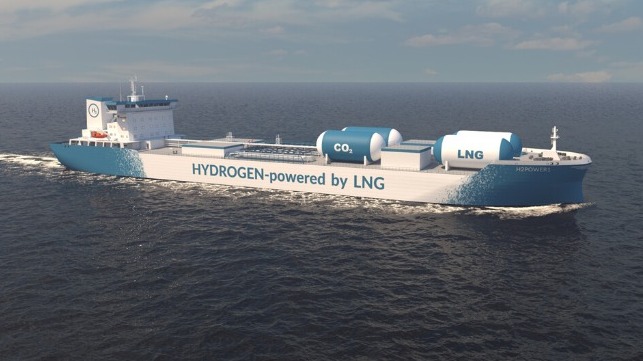Hydrogen MR Tanker Design Exceeds IMO Carbon Targets with Current Tech

In the race to develop next-generation environmentally friendly vessels, Italian classification society RINA working with Sweden’s FKAB Marne Design has developed a design for an MR tanker that exceeds the IMO’s 2050 targets for emissions reductions using currently available technologies. Conceived by the class society and designed by FKAB, propulsion is derived from LNG and onboard technologies that produce hydrogen for power while capturing the CO2 during a separation process for the LNG.
The MR tanker design is based on combining LNG with steam in a gas reformer technology developed by Helbio. The LNG molecules are split into hydrogen and CO2. The hydrogen is then used to fuel the internal combustion engines and/or fuel cells in a hybrid marine power system developed by ABB. The hydrogen produced can be used to power the main engine, fuel cells, or a hybrid of the two. The CO2 split from the LNG molecules is captured at the time of separation rather than from exhaust gas.
“The concept is revolutionary because it does not require any portside hydrogen infrastructure. The hydrogen is created onboard the vessel and all necessary equipment can be easily fitted on deck, so shipowners can convert existing vessels. The fuel cells have been specifically developed to produce more power and fewer emissions,” said Andreas Hagberg, Head of Sales & Marketing Department at FKAB.”
After a review of the design, RINA awarded an Approval in Principle (AiP) for the first of its kind hydrogen MR tanker to FKAB. According to the companies, this new design enables the use of hydrogen as a fuel today without the need for bunkering and storage on board and critically important exceeds the IMO 2050 targets for a 70 percent reduction of carbon intensity.
“Now that the concept has been brought to the real world through an immediately applicable CII A-rated design, this opens the door to reduce emissions in a much shorter timeframe,” said Trakakis. “The AiP is for an MR tanker, but the technology can be applied to a wide range of vessel types and sizes.”
RINA notes that any solution that aims to reduce a ships’ CO2 emissions should ensure a competitive Carbon Intensity Index (CII) rating. The CII standard being introduced by the IMO in 2023 has increasingly stringent rating thresholds towards 2030. RINA says that the CII rating should be measured throughout the whole service life of the vessel, not only when getting closer to 2050. This may however prove to be a substantial limitation for conventional ships built with the intention of being retrofitted after 10-15 years from delivery.
Using their new design, hydrogen usage can be progressively increased to maintain a top CII rating throughout the life of the ship, reducing CO2 emissions in a parallel slope with the applicable regulations. The ship can meet full decarbonization targets by either running the engine on 100 percent hydrogen or by producing all the power needed by fuel cells. In this way, the owner can decide the rate of CO2 reduction.
In addition to not requiring additional bunkering, aside from normal LNG, the concept does not require onshore carbon disposal technology to be available before 2032. The CO2 would be liquefied by the cryogenic steam from the LNG and can be used as the inert gas for the tanker. This provides time for the development of future carbon disposal technologies, which will be vital in the future to meet global decarbonization goals across all sectors.
